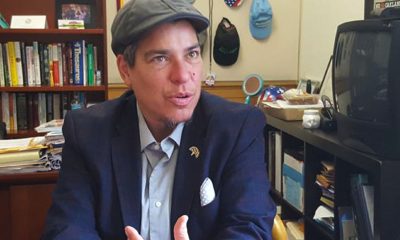City Government
Quan, Santana Accused of Thwarting Reform of Intake of Complaints Against OPD Officers.
Many supporters of increased police accountability to the community consider that it is a small step forward to take intake of complaints against police away from the police department and put it in the hands of neutral civilians.
But though the reform was passed two years ago, it has still not been implemented and is the center of ongoing disputes.
Some of those backing increased police accountability now are accusing City Administrator Deanna Santana and Mayor Jean Quan of thwarting the City Council’s decision to remove intake of complaints against officer from the Internal Affairs Division of the Oakland Police Department.
The agreement was for Santana to hire eight intake technicians by the middle of October. As approved by the City Council and asked for by community groups, these new intake workers are to be trained and placed at the offices of the Civilian Police Review Board (CPRB), not within Internal Affairs.
The intent of the council decision was to “consolidate” the intake function, which up to now has taken place both in Internal Affairs and the CPRB.
However, the job announcement released by Santana’s office says the positions will be located “within the Internal Affairs Division of the Oakland Police Department.” And operate “under general supervision in the Oakland Police Department (OPD).”
However, the council had allocated funding for the workers “in the City Administrator’s budget, to be utilized to expand the CPRB – not to hire intake personnel in Internal Affairs,” said Rashidah Grinage, executive director of PUEBLO, which has long worked with other community groups to increase police accountability.
“She changed that allocation from her budget to the police budget. She has no authority to do that – plain and simple,” said Grinage, who accused Santana of usurping the council’s powers that are determined by the City Charter.
“At what point do we say the City Council is irrelevant and the city administration will do whatever it wants?”
Santana and Mayor Quan, who is Santana’s boss, have to share responsibility for the decision on intake workers, Grinage said. “This is a question of undermining democracy in Oakland. We learned that this administration feels impunity to ignore public policy legislated by elected representatives.”
The council’s unanimous decision two years ago to move the intake function to the CPRB came after members of the public said they have had little confidence in going to the police department to file a complaint about the police.
There were also persistent complaints that Internal Affairs intake workers actively discouraged and sometimes intimidated those who tried to file complaints.
Santana sent an email Tuesday to Grinage in response to her concerns. She said the intake workers would be placed temporarily in Internal Affairs for the purpose of training.
“The Intake Technicians will first learn the process and methods of the current staff in the Intake Unit of Internal Affairs. The city must ensure that the new staff is properly trained and sufficiently performing the tasks of intake before those positions can be transferred to the CPRB,” Santana said in the email.
Santana also said her “action was consistent with input and comments made by the compliance director who expressed concern and/or questions about the transfer to CPRB.”
In response, Grinage said that if Santana believes the policy adopted by the council needed to be modified, she needs to present that as a proposal to the council, not unilaterally change policies at her own discretion.
Santana is violating the City Charter, said Grinage, because the charter says her job is “to execute and enforce all laws and ordinances and policies of the Council and to administer the affairs of the City,” not make policy.
In addition, Grinage said, “I am challenging Santana to produce a document from Tom Frazier (the compliance director) stating he directed her to essentially wipe out what the City council had ordered. I asked her to produce such a document by Sept. 4.”
Libby Schaaf, Council member from District 4, sees merit in Santana’s decision to train the new workers within Internal Affairs but underscores her commitment to moving complaint intake to CPRB.
“We are all very anxious to get these positions in place. This is something the council asked for more than two years ago. We’ve been frustrated that it has taken this long,” she said.
“We want this transition to go as quickly as possible,” she said. We will be vigilant to make sure that is what happens. I think the community has every right to be frustrated and a little skeptical because this has been delayed for so long.”
Councilmember Rebecca Kaplan reiterated her support for council’s original decision on complaint intake.
“It is essential that the reforms that I voted for and that the people have asked for be enacted, and I look forward to ensuring that it happens. We need to continue the important work of rebuilding trust and this is a critical step in that direction,” she said.
Local civil rights attorney Dan Siegel says the council and Quan shares responsibility if it does not stand up to Santana.
“Thecity y administrator is attempting to undermine the wishes of the people of Oakland to have police review civilianized. But we should not let the mayor or council off the hook. They’re complicit if they allow Santana to ride roughshod over the community’s wishes.”
At press time, Mayor Quan had not responded to questions submitted by the Post.
The hiring of the new intake technicians is scheduled to be discussed at the city’s finance committee meeting Tuesday, Sept. 10 at 2 p.m.
Activism
Oakland Post: Week of April 17 – 23, 2024
The printed Weekly Edition of the Oakland Post: Week of April 17 – 23, 2024

To enlarge your view of this issue, use the slider, magnifying glass icon or full page icon in the lower right corner of the browser window. ![]()
Bay Area
Oakland Finishes Final Draft of Downtown Specific Plan for Potential City Improvements
In late March, Oakland’s city administration announced the final draft of their Downtown Specific Plan, a blueprint for city improvements and developments over the next 20 years. The comprehensive 474-page plan lays out policies for downtown developments that will increase economic, social and cultural, and communal opportunities for residents and workers who frequent this essential hub in Oakland.

By Magaly Muñoz
In late March, Oakland’s city administration announced the final draft of their Downtown Specific Plan, a blueprint for city improvements and developments over the next 20 years.
The comprehensive 474-page plan lays out policies for downtown developments that will increase economic, social and cultural, and communal opportunities for residents and workers who frequent this essential hub in Oakland.
Several departments over the course of eight years developed the plan, with two phases that emphasized a need for community input from local stakeholders, such as leaders and residents, and a focus on the role of social and racial equity in past and future developments.
Throughout the extensive plan, the concept of equity for marginalized communities is embedded with each goal and priority for the improvements to downtown. It acknowledges that social and racial barriers are preventing these communities from thriving on an equal playing field.
The authors identified six key disparities, or ‘equity indicators’, that set the baseline for how success will be measured for the improvements. These indicators include the burden of housing costs, homelessness, displacement, disconnected youth, unemployment rate and median income.
The plan is also broken up into chapters, each describing a major issue or topic that is plaguing downtown residents and workers, such as mobility, culture preservation, community health and sustainability, and land use and urban design.
Within each chapter, the authors dedicate a section to the impacts of the COVID-19 pandemic for the various areas of interest, illustrating how disparities and inequities increased before and after the disease’s peak.
Two major issues highlighted in the plan are economic opportunity and housing and homelessness. Both of these issues have been aggravated by the pandemic and require substantial support and resources to move forward.
Many reports coming out of the commercial and residential districts downtown have blamed the rise in crime and cost of living as reasons for leaving Oakland for other cities or closing down indefinitely.
The plan attributes rising rents of both residential and commercial properties to the displacement of local businesses and entrepreneurs. Downtown also has an imbalance in the jobs to housing ratio, which limits access to jobs as commuting distances increase.
Other concerns for the local economy are barriers to employment opportunities for workers of color, non-English speakers, and those with limited access to transportation. As stated in the plan, downtown also has a lack of vacancies near public transit hubs, such as BART, bus stops or ferry terminals, which could save workers money and time for their commutes into the city.
According to the downtown plan, the average unemployment rate for the white population was 5.9%, but the Asian population was at 6.7%, and for the Black population it was even higher at 10.4%.
The proposed solutions for the lack of economic prosperity include providing assistance to local businesses owned by people of color, reinforcing downtown as the ‘place to be’ for nightlife entertainment, and building businesses closer to public transit.
The addition of over 18.3 million (m) sq. ft. of new commercial space, 1.3m sq. ft. of new institutional space, and 500,000 sq. ft. of new industrial space, could potentially create almost 57,000 jobs downtown.
Housing and homelessness, issues closely tied to economic prosperity, are top concerns for Oakland residents. High rents have led to displacement and homelessness for those unable to keep up with the rising costs of the Bay Area.
Over 5,000 people are currently experiencing homelessness in Oakland, according to 2022 Point In Time data. 60% of this population is Black despite only making up nearly 20% of the total city population.
The plan explains that by adding nearly 29,000 new homes and expanding affordable housing units across the city by 2040, this would help alleviate the stress of obtaining and affording a home.
Strategies proposed to tackle the housing and homelessness crisis include increasing renter protections, providing additional shelters and services for homeless residents, and promoting homeownership in downtown with first-time buyer assistance and proactive assistance to vulnerable homeowners.
The plan acknowledges that the implementation of changes and developments amongst the several concerns outlined in the document will take time, both in short and long term periods.
To better explain how and when each project will be addressed over the course of the next two decades, a detailed 123-page graph shows which agencies, potential funding sources, and costs come with the goals.
The Oakland Planning Commission and Landmarks Preservation Advisory Board will each hold public hearings regarding the final draft of the Downtown Plan in May and June.
City Government
LAO Releases Report on Racial and Ethnic Disparities in California Child Welfare System
Racial inequalities in California’s child welfare system disproportionately impact poor Black and Native American children, according to a report released April 3 by the nonpartisan Legislative Analyst’s Office (LAO). The report, which was presented to the Assembly Subcommittee No. 2 on Human Services — chaired by Assemblymember Corey Jackson (D-Moreno Valley) — states that the proportion of low-income Black and Native American children in foster care is four times larger than other racial and ethnic groups in the state.

Racial inequalities in California’s child welfare system disproportionately impact poor Black and Native American children, according to a report released April 3 by the nonpartisan Legislative Analyst’s Office (LAO).
The report, which was presented to the Assembly Subcommittee No. 2 on Human Services — chaired by Assemblymember Corey Jackson (D-Moreno Valley) — states that the proportion of low-income Black and Native American children in foster care is four times larger than other racial and ethnic groups in the state. Half of the children from each racial group has experienced some level of child welfare involvement before reaching legal age.
Jackson is a member of the California Legislative Black Caucus.
“Racial and ethnic disproportionality and disparities are present within initial allegations and persist at all levels of the system — becoming the most pronounced for youth in care,” the report states.
The disparities have persisted over the last decade across the state, the LAO found, adding that Black children living in poverty are more likely to enter foster care. State data shows that there is a correlation between poverty and foster placement in each county.
“Throughout all levels of the child welfare system, families experiencing poverty are more likely to come to the attention of and be impacted by the child welfare system,” stated the report.
Overall, the report revealed that more than half of the families affected by the state child welfare system earn $1,000 per month, significantly less than the national average of $5,000 a month.
The financial disparities highlighted in the LAO report align with existing research indicating that poverty is among the main factors contributing to the likelihood of child maltreatment. State anti-poverty programs include cash aid, childcare subsidies, supportive housing, and nutrition assistance.
-

 Activism4 weeks ago
Activism4 weeks agoOakland Post: Week of March 20 – 26, 2024
-

 #NNPA BlackPress3 weeks ago
#NNPA BlackPress3 weeks agoCOMMENTARY: D.C. Crime Bill Fails to Address Root Causes of Violence and Incarceration
-

 #NNPA BlackPress3 weeks ago
#NNPA BlackPress3 weeks agoMayor, City Council President React to May 31 Closing of Birmingham-Southern College
-

 #NNPA BlackPress4 weeks ago
#NNPA BlackPress4 weeks agoCOMMENTARY: Lady Day and The Lights!
-

 #NNPA BlackPress3 weeks ago
#NNPA BlackPress3 weeks agoFrom Raids to Revelations: The Dark Turn in Sean ‘Diddy’ Combs’ Saga
-

 #NNPA BlackPress4 weeks ago
#NNPA BlackPress4 weeks agoBaltimore Key Bridge Catastrophe: A City’s Heartbreak and a Nation’s Alarm
-

 Activism3 weeks ago
Activism3 weeks agoOakland Post: Week of March 27 – April 2, 2024
-

 #NNPA BlackPress3 weeks ago
#NNPA BlackPress3 weeks agoBaltimore’s Key Bridge Struck by Ship, Collapses into Water




















































